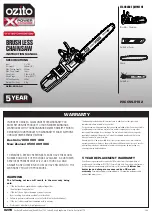
31
FUEL SYSTEM
CS-370ES
CS-420ES
4-9 Testing carburetor
NOTE: To perform this test, fuel should be inside
carburetor. If not, a little leakage may occur from
dry diaphragm and/or inlet needle seat.
1. Remove cylinder cover and disconnect fuel line
from carburetor. Connect pressure tester 897803-
30133 (A) to carburetor fuel inlet.
2. Apply pressure approx. 98 kPa (1 kgf/cm
2
) (14
psi).
3. If pressure remains steady, follow step 4 and 5. If
pressure drops, proceed to step 6.
4. Pull starter grip. Pressure tester reading should
drop and remain above 49 kPa (0.5 kgf/cm
2
) (7 psi).
5. If reading does not drop, inspect inlet needle valve
for sticking or metering lever height is too low.
6. If pressure drops at step 2, disconnect throttle
rod from carburetor (Refer to “9-4 Replacing throttle
trigger”) and remove switch bracket. Disconnect
choke rod from carburetor. Remove carburetor from
the unit.
7. Submerge carburetor in suitable clean solvent to
locate the leak by applying pressure approx. 98 kPa
(1 kgf/cm
2
) (14 psi).
8. If air bubbles come out between pump cover and
carburetor body (B), inspect pump diaphragm, pump
gasket, and diaphragm seat of carburetor body
(Refer to “4-13 Inspecting diaphragm”).
9. If air bubbles come out from throttle bore (C),
inspect inlet valve, metering lever spring, and
metering lever height (Refer to “4-11 Inspecting inlet
needle valve”).
4-10 Inspecting crankcase pulse passage
1. Drop a little oil in the end of pulse line as shown.
2. Remove spark plug and pull starter grip several
times. Oil should spit back from the hole.
3. If not, inspect whether pulse passage is blocked.
Repair as required.
A
C
B
Summary of Contents for CS-370ES
Page 1: ...Ord No 401 29 ...
















































